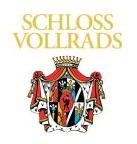
SCHLOSS VOLLRADS – A HISTORICAL RESUMÉ
The origin of the name Vollrads is uncertain, though it is probably derived from a family name, for in the year 1218, there is mention of a »Vollradus in Winkela« and again in 1268, a »Conradus dictus Vollradus armiger.« At the heart of the palace complex is a majestic tower surrounded by a rectangular moat that is only accessible by bridge. It was built in the first third of the 14th century and inhabited by a family who shaped the destiny of the palace and viticulture at Vollrads up to the days of our time: the dynasty of the Barons of Greiffenclau.
The building of the actual palace – next to the massive tower that Goethe described as »unusual« during his visit in 1814 – was commissioned by Georg Philipp von Greiffenclau in 1684. His son, Johann Erwein, sub-sequently constructed the adjoining farm buildings, added the Baroque roof to the tower and gave the cavalier’s house, originally built in 1650, its present appearance. The beautiful walls surrounding the garden were also built during this time. Generally speaking, the greater part of SCHLOSS VOLLRADS as its stands today is the work of Johann Erwein, and the many armorial designs decorating the farm buildings, the cavalier’s house and the gateway to the garden bear witness to his remarkable building activity. The most recent alterations to the palace were initiated in 1907/1908 by Countess Clara Matuschka-Greiffenclau, née Baroness von Oppenheim. She had an additional floor added to the south wing of the palace, the two towers built at each end facing the Rhine and the terraces enlarged. The family tree of the Greiffenclaus can be traced back to 1097. They originally lived in the Graues Haus (Gray House) in Winkel – said to be the oldest stone-built house in Germany. Records shows that Rhabanus Maurus, the bishop of Mainz, died here in the year 856. From about 1330, the family resided in the moated tower at Schloss Vollrads. Many of the Greiffenclau family were prominent personalities who served as patrons of the arts, as well as archbishops and electors of Mainz and Trier, and prince bishops of Würzburg. With the untimely death of Erwein Count Matuschka-Greiffenclau (†1997), the proprietorship of SCHLOSS VOLLRADS and its vineyards passed to the Nassauische Sparkasse (Nassau Savings Bank). It carries on the estate’s great viticultural tradition.
VITICULTURE AT SCHLOSS VOLLRADS – NOW AND THEN
The viticultural history of SCHLOSS VOLLRADS dates from the early Middle Ages. A document in the Mainz City Archives shows that on November 18, 1211, wines were sold to the St. Victor monastery in Mainz. Even in the Middle Ages Vollrads wines were a valuable commodity exported to towns along the Lower Rhine and in northern Germany. Then, as now, vines were cultivated on the south-facing slopes that still fan out in a semicircle around the palace. Today, this long tradition is enhanced by the most modern technical equipment and meticulous care in the cellars. The estate’s 60 hectares (148 acres) of vineyards are planted exclusively with Riesling grapes, the finest white wine grape grown in Germany. In order to achieve the highest quality of wine possible, SCHLOSS VOLLRADS cultivates Riesling grapes; controls yields through stringent pruning; practices ecologically-oriented vineyard maintenance; harvests its grapes late and selectively, by hand; and allows its wines to develop with as little interference as possible. Our cellarmaster strives to produce fruity Riesling wines that reflect their varietal character and to retain all the grapes’ natural aromas and minerals. We devote special attention to producing dry and off-dry Riesling wines that